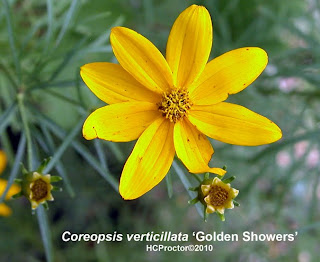Ted MacRae of Beetles in the Bush was kind enough to accept my challenge and supported my tentative guess about the Bronze Aspen Borer (Dicerca callosa) – the attractive jewel beetle (sounds nicer than flat-headed borer) whose genus I misspelled in the 1st edition of What if and What is it? Mystery Beetles of the Moose Pasture posting for the 2nd edition of An Inordinate Fondness that Amber and AJ did such an excellent job of hosting (if you haven’t visited yet, you should for both the beetles and the music). Meanwhile, I’ve found some additional images that may help confirm the identification (from a different time, but looks like the same beetle), and certainly help show why they are called jewel beetles. Ted also complimented me on my use of host information to narrow the field. That’s nice, but now I feel somewhat dumb, since I failed to use such logic elsewhere.
Ted also took a stab at the other mystery beetles, including the difficult (over 40 thousand species are known) members of the leaf beetle family Chrysomelidae. Of particular insight was his suggestion that my ‘another orange & black chrysomelid’ might belong to the genus Phyllobrotica. After much Googling and Bugnetting, I have come to the conclusion that Ted is right and in fact, this particular orange & black chrysomelid is the famous Phyllobrotica decorata - the North American Elegant Four-Spotted Black-bellied Marsh Skullcap Leaf, Flower & Root Eating Beetle (if I may be so descriptive and prolix as to try and outdo the Australian Ant-naming Alan Anderson).
Now that name may incur infamy, but usually such just desserts devolve because ‘leaf beetles’ eat our crops (e.g. asparagus, cucumber, and potato beetles), ornamentals (e.g. the Old World Viburnum Leaf Beetle), and street trees (e.g. the elm leaf beetle). But famous and infamous carry different implications: Phyllobrotica decorata’s fame rests on its diet, but only indirectly through the justly famous paper by Brian Farrell & Charles Mitter published in the journal Evolution (44:1389-1403) in 1990: Phylogenesis of insect/plant interactions: Have Phyllobrotica leaf beetles (Chrysomelidae) and Lamiales radiated in parallel? Not only have I read this paper, but I also assigned it as reading in a class; and yet, I didn’t recognize the beetle. Duh!
Although Phyllobrotica decorata appears to derive its species name from the Latin for ‘elegant’, it can be just as destructive as its pesky relatives – its larvae eat the roots and the adults feed on the leaves and on the sexual organs (aka flowers) of its host. But the host is the Marsh Skullcap (Scutellaria galericulata) – a widely distributed wildflower in the mint family that does very well along the margin of the lake at the Moose Pasture (in fact, if one looks at our pictures of the beetles, one sees that they are eating skullcap leaves!). A closely related 4-spotted species of Phyllobrotica feeds on the same skullcap in Europe and Asia.
According to Farrell & Mitter’s elegant and life-history-filled study, the Phyllobroticae (which more or less means ‘leaves for dinner’) tend to be ‘strictly monophagous’, meaning they tend to feed on only one kind of host plant. Since they feed on members of the mint family, this implies a specialized constitution. If you will recall an earlier posting on herbs, those essential oils we find so refreshing can be toxic and if your entire dinner is laced with them you will soon be a minty corpse. If you can feed on mints without ill-effect, however, not only will you have fresh breath, but at least two other avenues to a better life are open. First, you can eat all you can stomach with little competition from other mint-challenged herbivores. Second, if you can sequester some of those toxic chemicals, then you can make yourself distasteful to those predators that are considering you for dinner. That is the probable reason for the striking orange & black colouration – a warning to predators that you taste bad. Also, according to Farrell & Mitter, these host specialist beetles appear to be somewhat trapped by their specialization. As new species of skullcap evolved, so did new species of Phyllobrotica, but for the most part (one species has switched to mints in the genus Phyllostegia) the Phyllobroticae seem to have been unable to take advantage of other potential hosts with which they moved through evolutionary time.
And now for the double-duh development: the other mystery orange & black chrysomelid was labeled ‘Zygogramma sp.? feeding on willow’. Well, these are some Zygogramma that look a bit like this picture, e.g. the ragweed leaf beetle Z. suturalis, but except for being a little oranger than normal, this beetle is a dead ringer for a member of the Home Bug Garden fauna that I have posted on before, the Striped Willow Leaf Beetle Calligrapha californica. Not only that, but at the Moose Pasture this beetle was all over a composite last Fall – the Nodding Beggartick, Bidens cernua – a known host of the beetle, or at least for the subspecies Calligrapha californica corepsivora Brown which feeds on Coreopsis, Bidens (beggarticks), and Ambrosia (ragweed). Well, eating ragweed is good, but I have several species of Coreopsis in the Home Bug Garden and I’m not too keen on a generalist leaf beetle munching on them. Unlike the simple story the Phyllobroticae tell; however, the Calligraphae are complicated. Calligrapha californica may be a complex of cryptic species or populations with different host specializations. This could be just as interesting a story as with the Phyllobroticae, although much more difficult to work out, but I just hope none of the HBG visitors have a taste for coreopsis.
Water Beetle?
11 years ago














